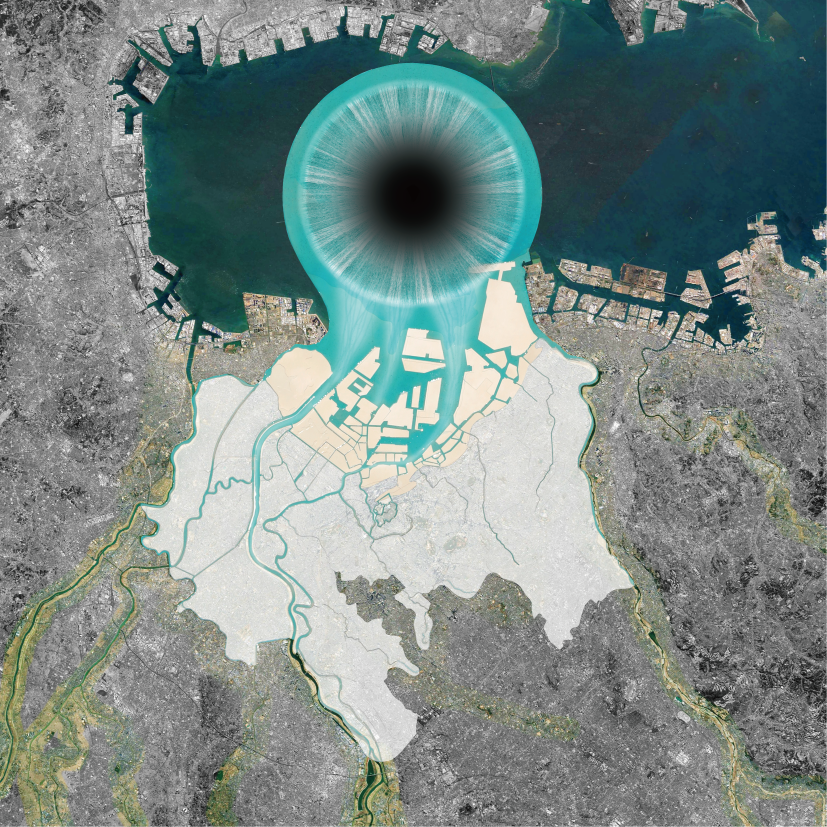When we talk about the Plan for the bay area of Tokyo, there are two plans cannot be ignored.
"A plan for Tokyo 1960" by Kenzo Tange's and "Obake Tokyo" by Taro Okamoto's.
Tange's Tokyo plan is already a historical heritage, and the robustness of its infrastructure has become an icon that represents the city of the 20th century.
But the Blue Infrastructure no longer has a unique form or meaning.
And the excess leisure space on Tokyo Bay, the "Leisure Island", drawn by Okamoto, has already been realized on the opposite of coastline,
that is, the Tokyo city on the land itself.
A city where humans work like machines, imaged in Fritz Lang's "Metropolis" around 1960, is revealed to be an illusion, since instead of, cities in the 20th century was no more than a place to do consumption and produces nothing. Energy such as electricity was one of the representative examples. The floating island in future Tokyo Bay should not be a "leisure island" such as a casino. To maintain the leisure function in the city, I think it is significant for us to consider Blue Infrastructure to generate energy by using water in Tokyo Bay.
A city where humans work like machines, imaged in Fritz Lang's "Metropolis" around 1960, is revealed to be an illusion, since instead of, cities in the 20th century was no more than a place to do consumption and produces nothing. Energy such as electricity was one of the representative examples. The floating island in future Tokyo Bay should not be a "leisure island" such as a casino. To maintain the leisure function in the city, I think it is significant for us to consider Blue Infrastructure to generate energy by using water in Tokyo Bay.
臨海部を含む東京計画で外せないものは二つある。
丹下健三の「東京計画1960」と岡本太郎の「お化け東京」である。
丹下の東京計画は既に歴史的遺産であり、そのインフラの強靭さは20世紀の都市を代表するイコンとなった。
しかし、ブルーインフラはもはや唯一的な形態や意味を持たない。
そして岡本が東京湾上に描いた「いこい島」に見た過剰な余暇の場は、むしろ東京という都市そのものに反転されて実現した。
1960年前後にイメージされたフリッツ・ラングの「メトロポリス」のような、人間が機械のように働く都市は実は幻想であり、 都市はむしろ何も生産しない消費の場であることが20世紀を通じて明らかになった。電気に代表されるエネルギーはその最たる対象であった。 未来の東京湾に浮かぶべき島はカジノなどの「いこい島」ではない。都市の憩いを維持するためには、東京湾に水を利用したエネルギーを生むブルーインフラを考えるべきであろう。
1960年前後にイメージされたフリッツ・ラングの「メトロポリス」のような、人間が機械のように働く都市は実は幻想であり、 都市はむしろ何も生産しない消費の場であることが20世紀を通じて明らかになった。電気に代表されるエネルギーはその最たる対象であった。 未来の東京湾に浮かぶべき島はカジノなどの「いこい島」ではない。都市の憩いを維持するためには、東京湾に水を利用したエネルギーを生むブルーインフラを考えるべきであろう。

In the "Reflected Obake-city" that seems to have been visualized by taking an X-ray of the city,
innumerable nervous systems can be seen extending in the river that flows from the inland of Tokyo to Tokyo Bay.
Each nerve is the mechanism that makes Tokyo, a huge consumer city, economically and politically dynamic. They extend toward the center of Tokyo Bay and lead to black eyes like black holes. Tokyo has become one of the world's largest consumers as the black eye continues to swallow money (capital), supplies (disposable mass-produced products), people, and energy flowing through this nervous system inexhaustibly. The ghosts never get full, so the black eyes continue to swallow them semi-permanently.
However, of course, capital and energy do not exist infinitely on the earth. Credit to money generated by the rotation of electronic money called virtual money is far from a joint illusion. The nuclear power generation invented by humankind in the 20th century could not be an infinite energy supplier, and the garbage called nuclear waste is also sealed deep inside the earth and pretended not to be seen. Not too much.
If the flow of the nervous system reverses through the blue infrastructure (sea, sea lanes, bays, harbors, rivers, culverts), this single-eyed black eye looks like a suction device that inexhaustibly absorbs and concentrates the city's desires. Rather, the ghost will be shown in the roentgen photograph as a reincarnated figure that supplies capital and energy from Tokyo Bay to the land.
Each nerve is the mechanism that makes Tokyo, a huge consumer city, economically and politically dynamic. They extend toward the center of Tokyo Bay and lead to black eyes like black holes. Tokyo has become one of the world's largest consumers as the black eye continues to swallow money (capital), supplies (disposable mass-produced products), people, and energy flowing through this nervous system inexhaustibly. The ghosts never get full, so the black eyes continue to swallow them semi-permanently.
However, of course, capital and energy do not exist infinitely on the earth. Credit to money generated by the rotation of electronic money called virtual money is far from a joint illusion. The nuclear power generation invented by humankind in the 20th century could not be an infinite energy supplier, and the garbage called nuclear waste is also sealed deep inside the earth and pretended not to be seen. Not too much.
If the flow of the nervous system reverses through the blue infrastructure (sea, sea lanes, bays, harbors, rivers, culverts), this single-eyed black eye looks like a suction device that inexhaustibly absorbs and concentrates the city's desires. Rather, the ghost will be shown in the roentgen photograph as a reincarnated figure that supplies capital and energy from Tokyo Bay to the land.
都市をレントゲンで撮影することで可視化されたかのような「反転・お化け都市」には、東京の内陸から東京湾へと注ぐ河川の中に無数の神経系が伸びているのが見える。
その神経一本一本が、東京という巨大消費都市を経済的、政治的に躍動させるメカニズムである。 それらは東京湾の中心へ向かって伸び、ブラックホールのような黒眼に繋がっている。黒眼がこの神経系を伝って流れるお金(資本)、物資(使い捨てられる大量生産品)、 人、エネルギーを無尽蔵に呑み込み続けることで、東京は世界有数の一大消費地となった。お化けは満腹になることはないから、黒眼はそれらを半永久的に呑み込み続ける。
しかし、当然ながら資本とエネルギーは、地球上に無限に存在するわけではない。 仮想貨幣と呼称される電子マネーの廻転作用で生まれる貨幣への信用も共同幻想となるには程遠い。 20世紀の人類が発明した原子力発電も無限のエネルギー供給体にはなり得なかったし、その核廃棄物というゴミも人類は地球の内部深くに封印して見て見ぬ振りをしているに過ぎない。
もしブルーインフラ(海、航路、湾、港、川、暗渠)を通じてその神経系の流れが逆流するならば、 都市の欲望を無尽蔵に吸収して一極集中させる吸引装置に見えるこの一眼の黒眼のお化けは、むしろ東京湾から陸へ資本とエネルギーを供給する転生した姿がレントゲン写真に映し出されるだろう。
その神経一本一本が、東京という巨大消費都市を経済的、政治的に躍動させるメカニズムである。 それらは東京湾の中心へ向かって伸び、ブラックホールのような黒眼に繋がっている。黒眼がこの神経系を伝って流れるお金(資本)、物資(使い捨てられる大量生産品)、 人、エネルギーを無尽蔵に呑み込み続けることで、東京は世界有数の一大消費地となった。お化けは満腹になることはないから、黒眼はそれらを半永久的に呑み込み続ける。
しかし、当然ながら資本とエネルギーは、地球上に無限に存在するわけではない。 仮想貨幣と呼称される電子マネーの廻転作用で生まれる貨幣への信用も共同幻想となるには程遠い。 20世紀の人類が発明した原子力発電も無限のエネルギー供給体にはなり得なかったし、その核廃棄物というゴミも人類は地球の内部深くに封印して見て見ぬ振りをしているに過ぎない。
もしブルーインフラ(海、航路、湾、港、川、暗渠)を通じてその神経系の流れが逆流するならば、 都市の欲望を無尽蔵に吸収して一極集中させる吸引装置に見えるこの一眼の黒眼のお化けは、むしろ東京湾から陸へ資本とエネルギーを供給する転生した姿がレントゲン写真に映し出されるだろう。